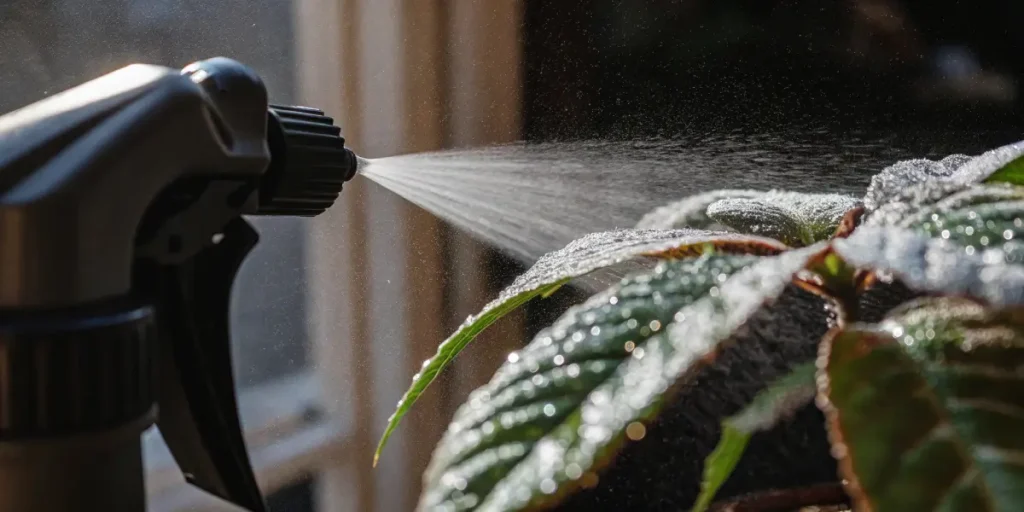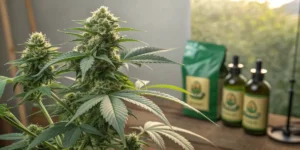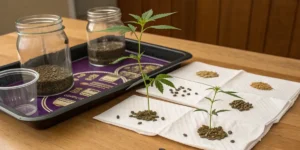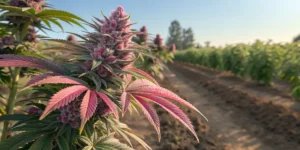Powdery mildew can be a grower’s nightmare. It’s a sneaky fungus that can spread rapidly if not handled properly. Learning how to clean grow room after powdery mildew is essential to ensure the health of your future plants. Ignoring it can lead to repeated failures and wasted time and resources.
Ensuring your grow room is free from powdery mildew starts with knowing the problem. This fungus loves warm, dry environments. It appears as white, powdery spots on leaves and stems, and can quickly spread if not addressed. Effective cleaning methods are necessary to prevent future outbreaks.
Whether you’re growing classic strains like OG Kush or something more exotic like Blue Dream, keeping your grow room pristine is key to a successful harvest. Let’s dive into the steps to clean your grow room post powdery mildew, ensuring that your cannabis plants thrive.
Steps to Clean Grow Room Post Powdery Mildew
Start by removing all infected plants and materials. This includes dead leaves, stems, and any plant matter showing signs of powdery mildew. Wearing gloves and protective clothing helps avoid spreading spores to other areas.
Next, clean all surfaces thoroughly. Use a mixture of water and hydrogen peroxide to wipe down walls, floors, and ceilings. Pay special attention to corners and crevices where spores might hide. A clean environment is crucial for preventing future mildew issues.
When considering how to clean grow room after powdery mildew, don’t forget to inspect ventilation systems. Dust and spores can accumulate in fans and ducts, so cleaning these components is vital. Use a vacuum with a HEPA filter to remove contaminants effectively.
After cleaning, keep the grow room dry and well-ventilated until you are ready to reintroduce plants. This helps to ensure that any remaining spores do not find favorable conditions to thrive. Regularly monitor the room for moisture buildup, especially during rainy seasons.
Best Cleaning Products for Grow Room Powdery Mildew
Choosing effective cleaning products is vital. Hydrogen peroxide is a popular choice due to its antifungal properties. Mix it with water in a 1:1 ratio for an effective cleaning solution. This mixture can be used on most surfaces without causing damage.
Consider using commercial mildew cleaners specifically designed for grow rooms. These products offer targeted solutions and are often safe for use around plants. Always follow the manufacturer’s instructions for the best results.
Bleach is another powerful disinfectant that can be used in grow rooms. Dilute it properly to avoid damaging sensitive surfaces. It is especially useful when used to soak tools and equipment, ensuring that all pathogens are effectively eliminated.
For those seeking eco-friendly options, tea tree oil and neem oil can be mixed into cleaning solutions. These natural oils have antifungal properties and leave behind a pleasant aroma, enhancing the overall environment of the grow room.
Grow Room Sanitation After Powdery Mildew Outbreak
Once you’ve cleaned the visible areas, focus on sanitation. This involves disinfecting grow room equipment. Tools like pruning shears, pots, and trays should be soaked in a bleach solution. Use one part bleach to nine parts water, and let items soak for at least ten minutes.
It’s also important to address the air quality in your grow room. Consider using an air purifier with a HEPA filter to remove airborne spores. This helps reduce the chance of recontamination and supports overall plant health.
As part of the steps to clean grow room post powdery mildew, regularly replace air filters in your ventilation system. Dirty filters can harbor spores and other contaminants, compromising the sanitation efforts you have made.
For optimal grow room sanitation after powdery mildew outbreak, ensure that all electronic equipment, such as lighting systems, is free from dust and mildew. Use a microfiber cloth to gently clean surfaces, taking care not to damage components.

Effective Methods for Cleaning Grow Room Mildew
Routine maintenance is paramount. Regularly inspect plants for signs of mildew. Early detection can prevent a full-blown outbreak. Remove affected leaves immediately to stop the spread.
Another effective method is to maintain optimal humidity levels. Powdery mildew thrives in high humidity, so keep levels between 40-50%. Use a hygrometer to monitor and adjust as needed.
Implementing a schedule for regular cleaning can significantly reduce the risk of mildew. By dedicating specific days for inspection and cleaning, growers can ensure that their environment remains conducive to healthy plant growth.
Additionally, integrating beneficial microorganisms such as Bacillus subtilis into your growing practices can help suppress mildew. These microbes create a hostile environment for fungi, adding an extra layer of protection to your grow room.
Cannabis Strains Resilient to Powdery Mildew
When selecting seeds, consider strains that are less prone to mildew. Northern Lights is a great option, known for its hardiness and resistance to mold. It’s a favorite among growers looking for a reliable yield.
Another excellent choice is the White Widow strain. This strain is not only resistant to mildew but also offers a potent high. It’s a classic choice for both new and experienced growers.
Blue Dream is another strain that offers resilience against powdery mildew. Its robust genetics make it a smart choice for growers seeking both yield and disease resistance. This strain is well-suited for various growing conditions.
By choosing strains like OG Kush and Northern Lights, you can focus on how to clean grow room after powdery mildew with confidence, knowing that your plants are naturally more resistant to outbreaks. This proactive approach saves time and resources in the long run.
Real-Life Examples of Successful Cleaning
A fellow grower recently shared their experience with cleaning their grow room after a mildew outbreak. They used a combination of vinegar and baking soda to scrub down surfaces, achieving great results.
Another grower opted for commercial mildew cleaning products and reported a significant decrease in mildew recurrence. They emphasized the importance of following up with regular checks and maintenance.
One grower noted that after implementing consistent cleaning schedules and using hydrogen peroxide solutions, their plants showed improved health and vigor. This highlights the effectiveness of combining natural and commercial products for optimal results.
In another case, a grower used an air purifier to enhance air quality, which significantly reduced mildew issues. This strategy, along with diligent cleaning, provided a holistic approach to maintaining a healthy grow room environment.

FAQs
What causes powdery mildew in a grow room?
Powdery mildew is caused by a group of fungi that thrive in warm, dry conditions. It can spread through air, water, or contact with infected plants. Poor air circulation and high humidity levels can exacerbate the problem, creating an ideal environment for mildew to flourish.
To prevent outbreaks, ensure proper ventilation in your grow room. Regularly inspect plants and maintain optimal humidity levels. Using resistant strains, like Blue Dream from Global Green Genetics can also help reduce the risk of mildew.
Knowing how to disinfect grow room after powdery mildew is crucial. Regular cleaning and maintenance, along with choosing mildew-resistant strains, create a robust defense against future outbreaks.
Implementing preventative measures such as improving airflow and reducing overcrowding in your grow space can further minimize the risk. These steps help create an environment less conducive to fungal growth.
How often should I clean my grow room?
Regular cleaning is crucial for preventing powdery mildew and other plant diseases. Aim to clean your grow room thoroughly after each harvest. This includes disinfecting surfaces and equipment. Between harvests, perform routine maintenance checks and clean up any debris or dead plant matter.
Consistency is key. Regular cleaning habits help maintain a healthy environment for your plants and can prevent the recurrence of mildew and other issues.
Incorporate deep cleaning sessions into your grow room management plan. By committing to a thorough clean at least once a month, you can significantly reduce the risk of mildew outbreaks.
Developing a checklist for cleaning tasks ensures nothing is overlooked. This organized approach ensures that all areas of your grow room receive the attention they need to stay mildew-free.
Can I use household products to clean my grow room?
Yes, many household products can be effective for cleaning grow rooms. Vinegar, hydrogen peroxide, and baking soda are all great options. They are natural, safe, and readily available. When using these products, ensure they are properly diluted to avoid any damage to surfaces.
For tougher cleaning tasks, consider using commercial products specifically made for grow rooms. These are designed to tackle mold and mildew effectively and are safe for use in plant environments.
Household products are not only cost-effective but also versatile. They can be used in various cleaning scenarios, providing a safe alternative to harsh chemicals.
Using a combination of household and commercial products can provide a balanced approach to cleaning. This strategy ensures that you have the right tools at your disposal for any cleaning challenge.
What are the signs of powdery mildew on cannabis plants?
Powdery mildew appears as white, powdery spots on the leaves and stems of plants. It can also cause leaves to become discolored or deformed. As the fungus spreads, plants may become stunted and produce lower yields.
Regularly inspecting your plants for these signs can help you catch and address powdery mildew early. Removing affected leaves and improving air circulation are effective first steps in managing an outbreak.
Recognizing signs of powdery mildew early can save your grow operation from significant losses. Implement routine inspections as part of your daily maintenance tasks.
Knowing how to clean grow room after powdery mildew includes educating yourself on identifying symptoms early. This knowledge empowers you to take swift action, minimizing potential damage.
How can I prevent powdery mildew from returning?
Prevention involves maintaining a clean and well-ventilated grow room. Regularly clean surfaces and equipment, and monitor humidity levels. Keeping your grow room between 40-50% humidity can deter mildew growth. Consider using a dehumidifier if necessary.
Planting mildew-resistant strains, such as OG Kush from Global Green Genetics, can also help reduce the likelihood of future outbreaks. Consistent care and monitoring are essential for long-term prevention.
Incorporate preventative measures like spacing plants adequately to promote airflow. This helps create an environment that is less conducive to mildew growth, ensuring healthier plants.
Creating a comprehensive prevention plan that includes regular cleaning, ventilation adjustments, and strain selection can be your best defense against mildew. This proactive approach is key to long-term success.





